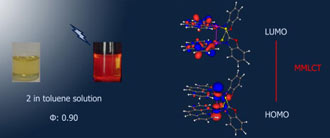|
The half-lantern compound [{Pt(bzq)(μ-C7H4NOS-κN,S)}2] (2) (bzq = benzo[h]quinoline, C7H4NOS = 2-mercaptobenzoxazolate) was prepared selectively by reaction of equimolar amounts of potassium 2-mercaptobenzoxazolate (KC7H4NOS, 1) and [Pt(bzq)(NCMe)2]ClO4. Complex 2 undergoes two-electron oxidation by reaction with halogens X2 (X2: Cl2, Br2 or I2) to give the corresponding dihalodiplatinum (III) complexes [{Pt(bzq)(μ-C7H4NOS-κN,S)X}2] (X = Cl 3, Br 4, I 5). The X-ray structures of 3 - 5 confirm the retention of the half-lantern structure and the shortening of the Pt-Pt distance (Pt-Pt = 2.6383(3) Å 3, = 2.6671(9) Å 4, 2.6810(5) Å 5) with respect to that in 2 (2. 9726(8) Å) because of the Pt-Pt bond formation. The trend of increasing Pt-Pt distances is in accordance with the trans-influence of the axial ligand (Cl< Br< I). DFT calculations on complex 2 in CH2Cl2 indicate the lowest energy absorption band to be mainly due to singlet metal-metal-to-ligand charge transfer (1MMLCT) [dσ*(Pt-Pt) →π*(bzq)] really affected by the π…π contacts in the complex, with just a little ligand-to-ligand charge transfer/intraligand (L’LCT /IL) character. The triplet 3MMLCT excited state seems to be the responsible of the structureless red emission of 2 in the solid state and in solution at room temperature. The quantum yield (90%) of this red emission in toluene solution at room temperature is really high. This fact added to the neutral character and the thermal stability of 2 make it a potential compound to be incorporated as phosphorescent dopant in multi-layer OLEDs.
|

